Sacred Symbols of Śaivism
Maṅgala Śaiva Lakshaṇa
मंगलशैवलक्षण
ENDEARING IMAGES EMBODYING INTUITIONS OF THE SPIRIT THAT ADORN HINDU ART, ARCHITECTURE AND ICONOGRAPHY
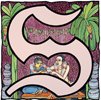 YMBOLS ADORN OUR WORLD AND MIND AT EVERY TURN—IN OUR SPIRITUAL, SOCIAL AND POLITICAL EXPERIENCE. A RING OR GOLD PENDANT SERVES TO SILENTLY ATTEST TO AND STRENGTHEN WEDDED LOVE. ON A MOUNTAINOUS ROAD IN ANY COUNTRY, a sign with a truck silhouette on a steeply angled line warns drivers of dropping grades ahead. The red cross signals aid and comfort in crises. Golden arches tell the vegan to beware. Among the best known symbols in the world are the simple numerals: 0, 1, 2, 3, 4, 5, 6, 7, 8 and 9. They originated in ancient India as characters of the Brahmi script. Now and then, historic images or happenings are supercharged into symbols. The awesome mushroom cloud of the atom bomb will forever represent the terrifying specter of nuclear destruction. §
YMBOLS ADORN OUR WORLD AND MIND AT EVERY TURN—IN OUR SPIRITUAL, SOCIAL AND POLITICAL EXPERIENCE. A RING OR GOLD PENDANT SERVES TO SILENTLY ATTEST TO AND STRENGTHEN WEDDED LOVE. ON A MOUNTAINOUS ROAD IN ANY COUNTRY, a sign with a truck silhouette on a steeply angled line warns drivers of dropping grades ahead. The red cross signals aid and comfort in crises. Golden arches tell the vegan to beware. Among the best known symbols in the world are the simple numerals: 0, 1, 2, 3, 4, 5, 6, 7, 8 and 9. They originated in ancient India as characters of the Brahmi script. Now and then, historic images or happenings are supercharged into symbols. The awesome mushroom cloud of the atom bomb will forever represent the terrifying specter of nuclear destruction. §
It is humanity’s sacred symbols, its icons of Divinity and Reality, that wield the greatest power to inform and transform consciousness. Taoists gazing upon a yin-yang symbol, Navajo Indians delicately pouring a feather symbol in a sand painting, Muslims embroidering the crescent moon and star, Tibetan Buddhists contemplating an intricate mandala, Christians kneeling before the cross, Hindus meditating upon the Aum, Pagans parading the ankh at Stonehenge—all these images, and hundreds more, communicate cosmic belief structures and function as gateways to inner truths. §
To the societies of prehistory (ca 7,000-4,000 BCE), living fully in the raw splendor and power of nature, symbols and icons represented supernatural states and beings—as they still do for us today. A stylized image of a snake coiled around the top of a clay vase communicated a complex and abstract idea, interpreted by anthropologist Marija Gimbutas as cosmic life force and regeneration.§
Wielded by mystic priests, or shamans, symbols serve as psychic tools for invoking invisible cosmic beings and shaping the forces of nature. Thus, to conjure power, a medieval alchemist would enclose himself in a magic circle (a worldwide symbol) filled with geometric pictograms symbolizing astral-plane realities. §
Today, as in prehistoric epochs, religious symbols often draw on the forces of nature. The sun flares into prominence among these symbols, appearing in a spectrum of motifs across cultures from Mexico to Mongolia. Hinduism developed dozens of solar symbols, including the swastika and the wheel of the sun, which was adopted by the Buddhists as their eight-spoked dharma wheel. §
Hinduism has amassed a range of didactic icons from thousands of years back. Coins found in the Indus Valley have carried the symbols of the cow and of the yogi seated in meditation across a 6,000-year corridor of time. Many images from the Vedic age have become popular motifs in Kashmiri carpets and Chidambaram sārīs. These serve, significantly, to identify and distinguish members of a sect or community. The simple red dot worn on the forehead of many devout Hindus is both the mark of our dharmic heritage and the personal reminder to all who wear it that we must see things not only with our physical eyes, but with the mind’s eye, the third eye.§
India’s adepts and seers have excelled at symbolic imagery, transforming mudrās (hand gestures) into instantly recognized emblems and transmitters of a Deity’s power or a particular frequency of energy. Each accoutrement of the dozens of Deities in the Hindu pantheon conveys a cosmic function, force or capacity. Today this ancient magic is carried forward in a multitude of ways, from the temple priest’s invocation to the Indian housewife’s drawing of multi-colored designs, called kolams or rangoli, on the ground as auspicious auguries, household blessings and greetings.§
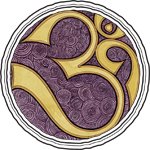 प्रणव ॐ
प्रणव ॐ
Praṇava, Aum, is the root mantra and primal sound from which all creation issues forth. It is associated with Lord Gaṇeśa. Its three syllables stand at the beginning and end of every sacred verse, every human act. Aum.§
 गणेश
गणेश
Gaṇeśa is the Lord of Obstacles and Ruler of Dharma. Seated upon His throne, He guides our karmas through creating and removing obstacles from our path. We seek His permission and blessings in every undertaking. Aum.§
 वट
वट
Vaṭa, the banyan tree, Ficus indicus, symbolizes Hinduism, which branches out in all directions, draws from many roots, spreads shade far and wide, yet stems from one great trunk. Śiva as Silent Sage sits beneath it. Aum.§
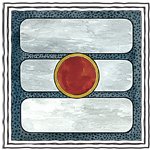 त्रिपुण्ड्र
त्रिपुण्ड्र
Tripuṇḍra is a Śaivite’s great mark, three stripes of white vibhūti on the brow. This holy ash signifies purity and the burning away of āṇava, karma and māyā. The bindu, or dot, at the third eye quickens spiritual insight. Aum.§
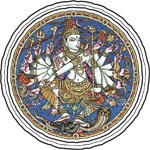 नटराज
नटराज
Naṭarāja is Śiva as “King of Dance.” Carved in stone or cast in bronze, His ānanda tāṇḍava, the fierce ballet of bliss, dances the cosmos into and out of existence within the fiery arch of flames denoting consciousness. Aum.§
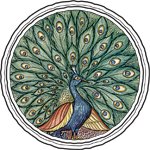 மயில்
மயில்
Mayil, “peacock,” is Lord Murugan’s mount, swift and beautiful like Kārttikeya Himself. The proud display of the dancing peacock symbolizes religion in full, unfolded glory. His shrill cry warns of approaching harm. Aum.§
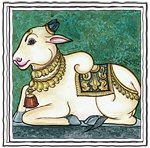 नन्दि
नन्दि
Nandi is Lord Śiva’s mount, or vāhana. This huge white bull with a black tail, whose name means “joyful,” disciplined animality kneeling at Śiva’s feet, is the ideal devotee, the pure joy and strength of Śaiva Dharma. Aum.§
 बिल्व
बिल्व
Bilva is the bael tree. Its fruit, flowers and leaves are all sacred to Śiva, liberation’s summit. Planting Aegle marmelos trees around home or temple is sanctifying, as is worshiping a Liṅga with bilva leaves and water. Aum.§
 पद्म
पद्म
Padma is the lotus flower, Nelumbo nucifera, perfection of beauty, associated with Deities and the chakras, especially the 1,000-petaled sahasrāra. Rooted in the mud, its blossom is a promise of purity and unfoldment. Aum.§
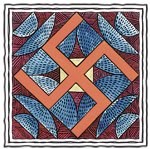 स्वस्तिक
स्वस्तिक
Swastika is the symbol of auspiciousness and good fortune—literally, “It is well.” The right-angled arms of this ancient sun-sign denote the indirect way that Divinity is apprehended: by intuition and not by intellect. Aum.§
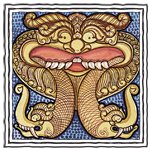 महाकाल
महाकाल
Mahākāla, “Great Time,” presides above creation’s golden arch. Devouring instants and eons, with a ferocious face, He is Time beyond time, reminder of this world’s transitoriness, that sin and suffering will pass. Aum.§
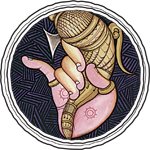 अंकुश
अंकुश
Aṅkuśa, the goad held in Lord Ganeśa’s right hand, is used to remove obstacles from dharma’s path. It is the force by which all wrongful things are repelled from us, the sharp prod which spurs the dullards onward. Aum.§
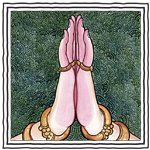 अञ्जलि
अञ्जलि
Añjali, the gesture of two hands brought together near the heart, means to “honor or celebrate.” It is our Hindu greeting, two joined as one, the bringing together of matter and spirit, the self meeting the Self in all. Aum.§
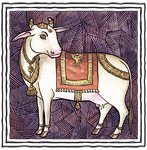 गो
गो
Go, the cow, is a symbol of the earth, the nourisher, the ever-giving, undemanding provider. To the Hindu, all animals are sacred, and we acknowledge this reverence of life in our special affection for the gentle cow. Aum.§
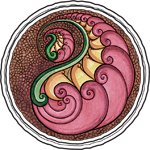 மாங்கோலம்
மாங்கோலம்
Mankolam, the pleasing paisley design, is modeled after a mango and associated with Lord Gaṇeśa. Mangos are the sweetest of fruits, symbolizing auspiciousness and the happy fulfillment of legitimate worldly desires. Aum.§
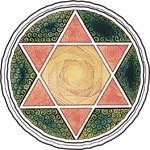 षट्कोण
षट्कोण
Shaṭkoṇa, “six-pointed star,” is two interlocking triangles; the upper stands for Śiva, purusha and fire, the lower for Śakti, prakṛiti and water. Their union gives birth to Sanatkumāra, whose sacred number is six. Aum.§
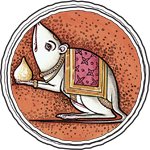 मूषिक
मूषिक
Mūshika is Lord Gaṇeśa’s mount, the mouse, traditionally associated with abundance in family life. Under cover of darkness, seldom visible yet always at work, Mūshika is like God’s unseen grace inour lives. Aum.§
 கொன்றை
கொன்றை
Konrai, Golden Shower, blossoms are the flowering symbol of Śiva’s honeyed grace in our life. Associated with His shrines and temples throughout India, the Cassia fistula is lauded in numberless Tirumurai hymns. Aum.§
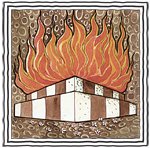 होमकुण्ड
होमकुण्ड
Homakuṇḍa, the fire altar, is the symbol of ancient Vedic rites. It is through the fire element, denoting divine consciousness, that we make offerings to the Gods. Hindu sacraments are solemnized before the homa fire. Aum.§
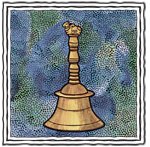 घण्टा
घण्टा
Ghaṇṭā is the bell used in ritual pūjā, which engages all senses, including hearing. Its ringing summons the Gods, stimulates the inner ear and reminds us that, like sound, the world may be perceived but not possessed. Aum.§
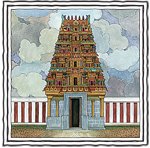 गोपुर
गोपुर
Gopuras are the towering stone gateways through which pilgrims enter the South Indian temple. Richly ornamented with myriad sculptures of the divine pantheon, their tiers symbolize the several planes of existence. Aum.§
 कलश
कलश
Kalaśa, a husked coconut circled by five mango leaves on a pot, is used in pūjā to represent any God, especially Lord Gaṇeśa. Breaking a coconut before His shrine is the ego’s shattering to reveal the sweet fruit inside. Aum.§
 குத்துவிளக்கு
குத்துவிளக்கு
Kuttuvilaku, the standing oil lamp, symbolizes the dispelling of ignorance and awakening of the divine light within us. Its soft glow illumines the temple or shrine room, keeping the atmospherepure and serene. Aum.§
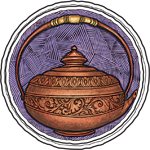 कमण्डलु
कमण्डलु
Kamaṇḍalu, the water vessel, is carried by the Hindu monastic. It symbolizes his simple, self-contained life, his freedom from worldly needs, his constant sādhana and tapas, and his oath to seek God everywhere. Aum.§
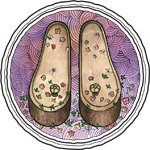 திருவடி
திருவடி
Tiruvadi, the sacred sandals worn by saints, sages and satgurus, symbolize the preceptor’s holy feet, which are the source of his grace. Prostrating before him, we humbly touch his feet for release from worldliness. Aum.§
 त्रिकोण
त्रिकोण
Trikoṇa, the triangle, is a symbol of God Śiva which, like the Śivaliṅga, denotes His Absolute Being. It represents the element fire and portrays the process of spiritual ascent and liberation spoken of in scripture. Aum.§
 சேவல்
சேவல்
Seval is the noble red rooster who heralds each dawn, calling all to awake and arise. He is a symbol of the imminence of spiritual unfoldment and wisdom. As a fighting cock, he crows from Lord Skanda’s battle flag. Aum.§
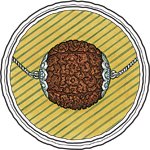 रुद्राक्ष
रुद्राक्ष
Rudrāksha seeds, Eleocarpus ganitrus, are prized as the compassionate tears Lord Śiva shed for mankind’s suffering. Śaivites wear mālās of them always as a symbol of God’s love, chanting on each bead, “Aum Namaḥ Śivāya.”§
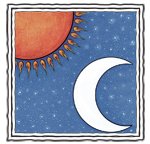 चन्द्र सूर्य
चन्द्र सूर्य
Chandra is the moon, ruler of the watery realms and of emotion, testing place of migrating souls. Sūrya is the sun, ruler of intellect, source of truth. One is piṇgalā and lights the day; the other is iḍā and lights the night. Aum.§
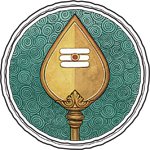 வேல்
வேல்
Vel, the holy lance, is Lord Murugan’s protective power, our safeguard in adversity. Its tip is wide, long and sharp, signifying incisive discrimination and spiritual knowledge, which must be broad, deep and penetrating. Aum.§
 त्रिशूल
त्रिशूल
Triśūla, Śiva’s trident carried by Himalayan yogīs, is the royal scepter of the Śaiva Dharma. Its triple prongs betoken desire, action and wisdom; iḍā, piṇgalā and sushumṇā; and the guṇas—sattva, rajas and tamas. Aum.§
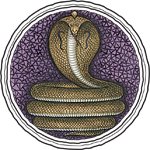 नाग
नाग
Nāga, the cobra, is a symbol of kuṇḍalinī power, cosmic energy coiled and slumbering within man. It inspires seekers to overcome misdeeds and suffering by lifting the serpent power up the spine into God Realization. Aum.§
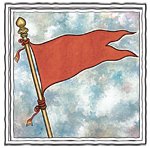 ध्वज
ध्वज
Dhvaja, “flag,” is the orange or red banner flown above temples, at festivals and in processions. It is a symbol of victory, signal to all that “Sanātana Dharma shall prevail.” Its color betokens the sun’s life-giving glow. Aum.§
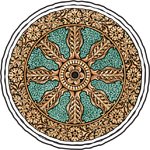 कालचक्र
कालचक्र
Kālachakra, “wheel, or circle, of time,” is the symbol of perfect creation, of the cycles of existence. Time and space are interwoven, and eight spokes mark the directions, each ruled by a Deity and having a unique quality. Aum.§
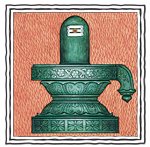 शिवलिङ्ग
शिवलिङ्ग
Śivaliṅga is the ancient mark or symbol of God. This elliptical stone is a formless form betokening Paraśiva, That which can never be described or portrayed. The pīṭha, pedestal, represents Śiva’s manifest Parāśakti. Aum.§
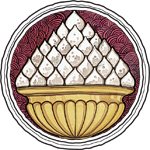 मोदक
मोदक
Modaka, a round, lemon-sized sweet made of rice, coconut, sugar and spices, is a favorite treat of Gaṇeśa. Esoterically, it corresponds to siddhi (attainment or fulfillment), the gladdening contentment of pure joy. Aum.§
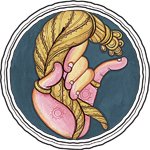 पाश
पाश
Pāśa, tether or noose, represents the soul’s three-fold bondage of āṇava, karma and māyā. Pāśa is the all-important force or fetter by which God (Pati, envisioned as a cowherd) brings souls (paśu, or cows) along the path to Truth. Aum.§
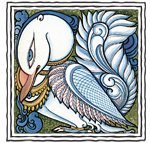 हंस
हंस
Haṁsa, vehicle of Brahmā, is the swan (more accurately, the wild goose Aser indicus). It is a noble symbol for the soul, and for adept renunciates, Paramahaṁsa, winging high above the mundane and diving straight to the goal. Aum.§